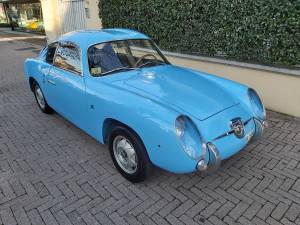Abarth 750 classic cars for sale
The Abarth 750, built on the Fiat 600 platform with Carlo Abarth’s signature performance upgrades, represents one of the most fascinating chapters of post-war Italian motorsport engineering. Its lightweight construction, innovative ‘Double Bubble’ Zagato design, and impressive power-to-weight ratio make it a sought-after rarity for true enthusiasts.
Search results

1958 | Abarth Fiat 750 Zagato GT
Abarth Fiat 750 Zagato GT Doppia Gobba (1958)
History of the Abarth 750
Abarth, the Turin-based manufacturer, shifted focus in the 1950s towards optimising Fiat cars for sport and performance. The 750 series emerged from this drive, debuting in 1956 as the 750 Berlina based on the Fiat 600. Abarth’s modifications radically improved power and driving experience, setting these models apart from their Fiat counterparts. As the series evolved, renowned coachbuilders like Zagato and Allemano lent their craftsmanship, with the famous ‘Double Bubble’ 750 GT Zagato introduced at the 1955 Turin Motor Show. Production continued into 1970, even after Fiat’s original running models had ceased, cementing the Abarth 750’s status not only in motorsport but also in automotive design and technology history.
Model History
The Abarth 750 traces its roots directly to the Fiat 600, drawing on its platform but transforming it with bespoke Abarth engineering. The earliest variant, the 750 Berlina, arrived in 1956. Its successors included a variety of forms, from the Siata-Abarth 750 by the acquired Siata brand to the aluminium-bodied 750 Zagato with its distinctive shape. The 750 GT Bialbero, first shown in 1958, delivered a notable increase in power. Over the years, engine displacement varied from 633 cc up to 747 cc, with performance advancing in parallel. The last units were produced in 1970. Model highlights also include the participation of the 750S in Le Mans 1960, underscoring the car’s racing intent and credentials.
Highlights and Features
The Abarth 750 series impresses with its characteristic power upgrade over its Fiat base, moving from an initial 16 kW to 29 kW in the early years, with later performance models reaching up to 47 kW. The lightweight aluminium Zagato body, famous for its aerodynamic ‘Double Bubble’ roof, distinguished the 750 even visually. Racing achievements include victories in national Italian championships and appearances at prestigious events like the Mille Miglia and Le Mans. Interiors typically featured black skai leather upholstery adapted to the car’s exterior colour, reflecting the attention to both performance and style. Many of these cars are ASI-certified for historical significance, and original examples have won awards at classic events.
Technical Data
Special Editions and Collectible Models
The Abarth 750 GT Zagato, commonly known as the ‘Double Bubble’ due to its signature roof design, stands apart as one of the most collectible variants. Further rare editions include the 750 GT Bialbero—distinguished by its dual-cam engine—and the Siata-Abarth 750, incorporating a unique chassis and uprated motor. Many original examples are ASI-certified, underpinning both their historic importance and authenticity.
Engine and Performance, Transmission and Handling
The Abarth 750 delivers an agile and characteristically lively driving experience due to its significant power boost and light weight. Revised engines, originally intended for racing, offer rapid acceleration for the period, and the double wishbone suspension helps deliver sharp response and communication. Transmission is manual, tuned for direct engagement. The Zagato-bodied models are especially valued for their handling due to the aerodynamic design and purposeful weight saving. - Abarth 750 GT Zagato: 747 cc, 42 PS, lightweight aluminium body, racing credentials.
- Abarth 750 Berlina: First production variant, 747 cc, 29 kW, up to 129 km/h.
- Abarth 750S: 698 cc, 47 kW, famous Le Mans participant in 1960.
- Abarth 750 GT Bialbero: Dual-cam engine, one of the highest-performing variants.
Interior, Comfort, Exterior and Design
The 750’s most recognisable visual cue is the aluminium ‘Double Bubble’ roof by Zagato, a hallmark of post-war Italian automobile design. Bodywork praised for its aerodynamic efficiency, paired with original paint schemes often adapted to motorsport needs. Interiors feature black skai leather with colour-matched piping. Specialist touches like unique badges, period-correct instrumentation, and a stripped-down cockpit underline the car’s motorsport ambitions. Many models were offered in special racing colours, and factory accessories were available for those destined for competition use.
Other Features
Many Abarth 750s remain in original mechanical specification, often with revivable chassis, electrics, and running gear. Certification (ASI, for instance) provides not just provenance but also assures value for historically genuine models. The car’s eligibility for events like the Mille Miglia adds another layer of desirability for dedicated collectors.
Summary
The Abarth 750 offers a unique blend of Italian sports engineering, coachbuilt elegance, and motorsport heritage. High demand and supply in today’s classic car market underscore the value enthusiasts place on these rare machines, especially those in original condition with racing pedigree or rare bodywork by Italian masters.
